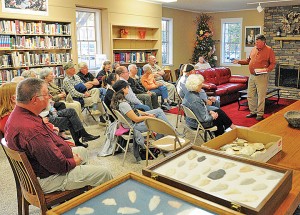10-22-15
Osage Indian talk
By Rob Viehman
Those working on the Osage Trail Legacy Project, which will feature a large-scale sculpture near the I-44 overpass, hosted a special presentation by well-known Osage Indian expert Jim Duncan at the Recklein Public Library last Friday night. Approximately 50 area residents were in attendance.
Duncan is a native Missourian born and raised in Jefferson City and his ancestry includes Osage, Cherokee, French, and Scots-Irish. Duncan served as director of the Missouri State Museum for several years and then as exhibits director for the Missouri Department of Conservation.
In 2003, Duncan was asked by the Conservation Department to direct the statewide Lewis and Clark programming during the Bicentennial from 2003 to 2006. At the close of that contract he retired, but continues to give lectures around the state. Along with his focus on the Osage, Duncan is also an archaeologist and author. He has co-edited three books and authored a number of published articles on archaeology, history, and American Indian iconography.
A social hour was held from 5 to 6 p.m. prior to Duncan’s presentation at 7 p.m. During that time many area residents were able to show their Native American artifacts to Duncan and get information about their history. Duncan also stayed after the presentation to provide more info.
Cuba Development President Dennis Roedemeier opened the evening by welcoming all those in attendance and introducing Duncan and his wife, Carol, who teaches at Washington University. Roedemeir said Duncan has been instrumental in helping local residents in their work with the Osage Nation in Oklahoma, noting that the tribe’s chief, Standing Bear, will be coming to Cuba later this month. Betty DeLeo then spoke briefly about the sculpture project before Duncan began his presentation, which was entitled “Majesty of the Osage.”
Before beginning his talk, which was accompanied by a slide presentation, Duncan spoke briefly about ethics in archeology, noting that there are certain things you don’t want to do anymore, like dig in an Indian mound. He believes there is unreported rock art in this area and it is incredibly important and needs to be preserved.
Duncan showed the crowd a book he and his wife published about a Missouri cave that has more than 400 images inside it. Pigment dating on images revealed they are more than 1,000 years old and were done before the mounds were build in the St. Louis region.
Duncan said the Osage people are descendants of the Western Mississippians, who built some of the largest earthen mounds in the world. The mounds were built for religious reasons and were the centerpieces of prehistoric cities of 10,000 to 20,000 people. Monks Mound, near Cahokia, Ill., is larger than the great pyramid in Eygpt and was built in less than 20 years. It has a 55-acre plaza in front of it.
Duncan said the historic Osage Tribe believed in one “god” or great spirit that made everything and the modern tribe still has two Native American churches. He showed paintings of the Osage from the 1800s, noted they were very warlike and did a lot of hand-to-hand fighting with war clubs, and were largely at war with everyone around them.
He also discussed Osage art, which is still practiced today, and recommended residents visit the Osage Tribal Museum in Pawhuska, Okla. Duncan said there are almost 15,000 Osage now, up from 2,500 in 1900. He said the tribe is bring its language back and is very dedicated to its children.
On October 28-30, the Osage Trail Legacy Project will be hosting Chief Geoffrey M. Standing Bear, head of the Osage Nation. Traveling with the chief will be Jason Zaun (Chief of Staff), Drew Pierce (Osage Supreme Court Justice), Dr. Amdea Hunter (Historical Preservation Director), Van Bighorse (Cultural Director) and Johnny Williams (Advisor to the Chief).

